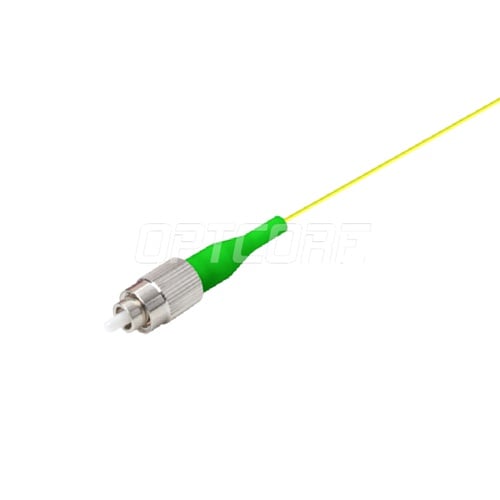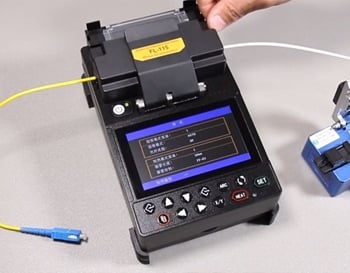Network Cabling, Optical Networking
What is Fiber Pigtail? A Complete Guide for Beginners
A fiber pigtail is typically a fiber optic cable with one end factory pre-terminated fiber connector and the other exposed fiber. It is usually suitable for field termination using a mechanical or fusion splicer. Compared with quick termination or epoxy and polish connections placed on the field site, the pre-terminated connectors provide time-saving, superior performance, and reliability.
In this guide, I will discuss the fiber optic pigtail basics, differences, types, and splicing.
Fiber Pigtail vs. Fiber Patch Cord: What Is the Difference?
Some guys may need clarification about fiber optic pigtails and patch cords. What is the similarity, and what is the difference?

First, the most critical difference is the fiber connector. Fiber optic pigtails have only one terminated connector on one side but bare fibers on another side. In contrast, the patch cords have two or more pre-terminated connectors on each side and have no bare fibers.
Second, the difference is the fiber cable types. Fiber optic pigtails typically use an unjacketed cable like a 90μm diameter cable. However, the patch cords usually use jacketed fiber cables, such as 2.0mm or 3.0mm fiber.
Third, the different applications. Fiber optic pigtails are mainly for fast fusion splicing applications, while patch cords are for connectivity between optical transceivers, patch panels, and backbone networks.
Finally, as a simple but quick method, we can cut a fiber patch cord into two pieces to make two pigtails. That is because it is difficult to test a pigtail in the field. Before the pigtail is spliced to the equipment, it is challenging to test the unterminated end.
Fiber Pigtail Types
There are many types of fiber pigtails based on one different factor. Fiber connector types include LC pigtails, SC pigtails, ST pigtails, FC pigtails, MU pigtails, and E2000 pigtails. By fiber types, including single mode and mulitmode pigtails.
Next, Let us have a closer look at the fiber pigtails types.
By Fiber Type
Generally, fiber optic pigtails are classified as multimode and single-mode fiber.
- Multimode pigtails are made with 62.5/125μm or 50/125μm bulk multimode fiber cables and terminated with multimode connectors. However, if we want to classify them in more detail, we can divide them into OM1, OM2, OM3, OM4, and OM5 pigtails.
- Single mode pigtails are made with 9/125μm OS1 or OS2 bulk single mode fiber cables and terminated with single mode connectors.
Generally, pigtails are utilized in 99% of single mode applications but are also used in many multimode applications.
By Connector Type
Based on the fiber connector type, we can divide the fiber pigtails into LC pigtails, SC pigtails, ST pigtails, FC pigtails, MU pigtails, E2000 pigtails, MPO pigtails, and so on. Next, Let’s take a close look at the regular types.
LC Fiber Pigtail
LC connectors are compact form factor fiber connectors for high-density connections. They are a 50% smaller version of the older SC fiber connector and have a square plastic enclosure with a 1.25mm ceramic ferrule. The LC fiber pigtails are pre-assembled with an LC connector. It is one of the most common types.

SC Fiber Pigtail
SC, which stands for Subscriber Connector, has also been called Square Connector or Standard Connector. The SC connector has a 2.5mm pre-radiused zirconia or stainless alloy ferrule. The SC fiber pigtails are pre-assembled pigtails with an SC connector. Because of the low cost, longevity, and ease of installation, SC pigtail is commonly used in both P2P and PON applications.

FC Fiber Pigtail
FC fiber pigtails benefit from the metallic body of FC optical connectors, which have a screw-type structure and high-accuracy ceramic ferrules. FC fiber pigtails and related items are widely used in various applications.

ST Fiber Pigtail
ST fiber pigtail is similar to the FC pigtail, but instead of threads, the ST connector has a locking mechanism different from FC connectors. It has a ferrule with an extended 2.5mm diameter composed of ceramic (zirconia), stainless alloy, or plastic. As a result, ST pigtails are commonly used in telecom, industry, medical, and sensor applications.

By Interface Polish Type
PC Fiber Pigtail
PC is an abbreviation for “physical contact” connector. A PC fiber pigtail made with physical contact polished connector. Most multimode pigtails are PC polished and widely used in the telecom sector and data systems.
UPC Fiber Pigtail
UPC stands for “ultra physical contact”. Unlike the PC fiber pigtail, this pigtail is made of a UPC connector with improved physical contact for reducing air gaps and lowering ORL even further. It is the most commonly polished type for single mode and multimode pigtails.
APC Fiber Pigtail
APC stands for “Angled physical contact”. It is designed to reduce back reflection even further. These connectors’ ferrule end faces are polished at an angle of 8 degrees. APC fiber pigtails are typically used in CATV, FTTx, and other WDM systems.
By Application Environment
Based on the different application environments, the fiber pigtails are classified as Regular Indoor Pigtail, Armored Pigtails, and Waterproof Pigtail.
Regular Indoor Pigtail
The most common type is the regular indoor pigtail, which has no extra protection and is bare fiber. It provides the best cost and tighter bend radius for the easily cabling. As its name suggests, these pigtails are only for indoor use and unsuitable for harsh environments.
Armored Pigtail
Enclosed with a stainless steel tube inside the outer jacket, the armored pigtail protects against damage caused by rats, construction activities, and the weight of other cables.
Waterproof Pigtail

The Waterproof fiber pigtail is made of rugged fiber connectors and has a stainless steel reinforced waterproof device and armored outdoor PE jacket. So it can protect the cable from twisting, pressure, or damage by mouse bites. The Waterproof fiber pigtail is intended for use in harsh outdoor environments, such as communication towers, military applications, etc.
By Fiber Count
The most common fiber pigtails have one fiber count, such as the simplex LC pigtail consists of one bare fiber with one terminated LC connector.

However, in some cases, the fiber count is also available in 2, 4, 6, 8, 12, 24, 48, and 72. Each fiber pigtail should be color-coded according to industry standard TIA-EIA-598-A.
By Fiber Construnture
Based on the fiber cable structure, we can divide them into Multi-fiber bundle pigtail, multi-fiber robbin pigtail, 0.9mm pigtail, and 2.0/3.0mm pigtail.
Fiber Pigtail Splicing
Mechanical Splicing
Mechanical Splicing is a simple alignment device that allows light to enter from one fiber to the other by holding the ends of the two fibers in precise alignment. This method has been around for many years. It continues to be popular because it provides immediate, straightforward termination with a limited waste of results as it requires fewer consumables than traditional epoxy/polished connector methods. Mechanical fusion splicing has a lower initial investment but a higher cost per splice.
Fusion Splicing

Fiber fusion splicing is a technique that uses high temperatures generated by the discharge between electrode rods to fuse optical fibers. Fiber splicing is stronger than mechanical fusion splicing, producing less loss and back reflection because the resulting splice point is virtually seamless. However, this method requires an expensive fiber optic fusion splicer, resulting in a higher initial investment but a lower cost per splice.
However, there is no one-size-fits-all field termination method. Users must choose the best way based on their situation, considering and balancing the optical loss budget, time, and cost considerations.
Final Words
As a vendor in fiber optic connectivity, Optcore provides a total fiber optic pigtails solution to meet your one-stop connectivity needs. We are always here to provide the best support for you, no matter your specific scenario.
Reference:
Read more:
- The Best Optcore Fiber Patch Cables for Home Network
- 11 Things You Need to Know About Fiber Patch Cable
- 16 Tips On How To Save Fiber Cabling Cost







LOOKING FOR PRICING ON 50′ 48 AND 72 COUNT LC PIGTAI FOR HEADEND USE